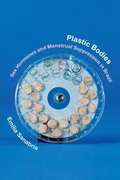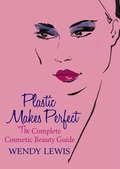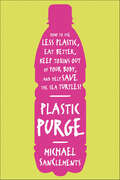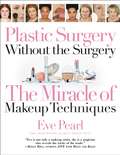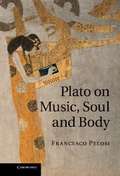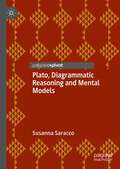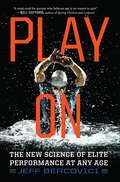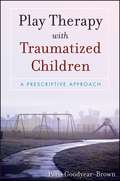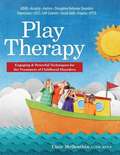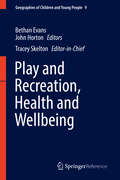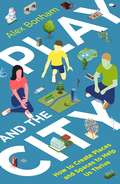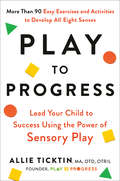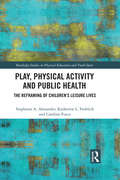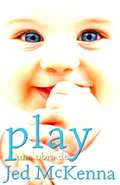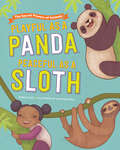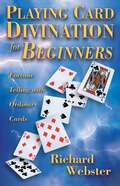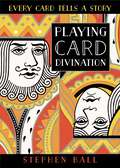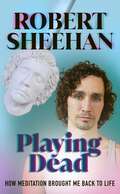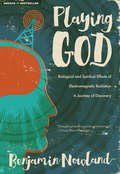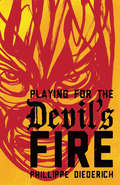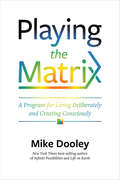- Table View
- List View
Plastic Bodies: Sex Hormones and Menstrual Suppression in Brazil
by Emilia SanabriaIn Plastic Bodies Emilia Sanabria examines how sex hormones are enrolled to create, mold, and discipline social relations and subjectivities. She shows how hormones have become central to contemporary understandings of the body, class, gender, sex, personhood, modernity, and Brazilian national identity. Through interviews with women and doctors; observations in clinics, research centers and pharmacies; and analyses of contraceptive marketing, Sanabria traces the genealogy of menstrual suppression, from its use in population control strategies in the global South to its remarketing as a practice of pharmaceutical self-enhancement couched in neoliberal notions of choice. She links the widespread practice of menstrual suppression and other related elective medical interventions to Bahian views of the body as a malleable object that requires constant work. Given this bodily plasticity, and its potentially limitless character, the book considers ways to assess the values attributed to bodily interventions. Plastic Bodies will be of interest to all those working in medical anthropology, gender studies, and sexual and reproductive health.
Plastic Makes Perfect: The Complete Cosmetic Beauty Guide
by Wendy LewisThe must-have guide to cosmetic surgery written by the world's leading independent consultant.Cosmetic surgery, once the preserve of the jet-setting rich, is now something more people than ever are prepared to consider, and the industry is worth almost £700 million in the UK alone. But what is involved, what are the risks and how much does it cost?This comprehensive guide by one of the world's leading experts outlines all the latest surgical procedures and non-invasive treatments and gives the facts you need to make an informed decision on whether it is right for you. Giving the reader the low down on the most popular cosmetic surgical procedures and the non-surgical alternatives, Wendy provides details on the very latest techniques and procedures, the questions to ask, the resources to help you find the best doctors, hints on speeding post-op recovery and the ways to negotiate potential pitfalls.Deciding to have a cosmetic procedure is a very personal journey to embark on. PLASTIC MAKES PERFECT is filled with expert but friendly advice on one of the most important life-altering decisions we can make.
Plastic Makes Perfect: The Complete Cosmetic Beauty Guide
by Wendy LewisCosmetic surgery, once the preserve of the jet-setting rich, is now something more people than ever are prepared to consider, and the industry is worth almost £700 million in the UK alone. But what is involved, what are the risks and how much does it cost?This comprehensive guide by one of the world's leading experts outlines all the latest surgical procedures and non-invasive treatments and gives the facts you need to make an informed decision on whether it is right for you. Giving the reader the low down on the most popular cosmetic surgical procedures and the non-surgical alternatives, Wendy provides details on the very latest techniques and procedures, the questions to ask, the resources to help you find the best doctors, hints on speeding post-op recovery and the ways to negotiate potential pitfalls.Deciding to have a cosmetic procedure is a very personal journey to embark on. PLASTIC MAKES PERFECT is filled with expert but friendly advice on one of the most important life-altering decisions we can make.
Plastic Purge: How to Use Less Plastic, Eat Better, Keep Toxins Out of Your Body, and Help Save the Sea Turtles!
by Michael SanClementsNow a Denver Post #1 bestseller. Plastic is everywhere we look. Our computers and children's toys are made out of it, and our water and slices of American cheese are packaged in it. But why is there so much and what is it doing to our bodies? Is it possible to use less plastic and be happier and healthier?In Plastic Purge, ecologist, SanClements has put together the most up-to-date and scientifically-backed information available to explain how plastics release toxins into your body and the effect they have on your and your children's health. Both approachable and engaging, Plastic Purge provides easy-to-follow advice for how to use less plastic, thereby reaping the benefits such as eating a healthier diet and living with less clutter. Dividing plastics into three separate categories: the good, the bad, and the ugly, SanClements shows you how to embrace the good (items like your phone or medical equipment), avoid the bad (food storage containers and toys that contain toxic chemicals), and use less of the ugly (single-use plastic that's just plain wasteful).With the help of Michael SanClements's Plastic Purge, you and your family will develop easy habits to live a healthier and happier lives.
Plastic Surgery Without the Surgery: The Miracle of Makeup Techniques
by Eve PearlAn Emmy Award-winning celebrity makeup artist presents a practical guide that reveals proven makeup techniques to correct flaws-without going under the knife. Many people would love to change some part of their bodies. In fact, they spend millions of dollars on products and undergo risky, expensive surgery in the hopes of improving their looks. Plastic Surgery Without The Surgery is a new kind of makeup book that demonstrates how readers can accentuate their features and correct flaws-easily and inexpensively-using proven makeup techniques. With easy-to-follow, professional secrets and four-color photos throughout, Eve Pearl, the Emmy Award-winning makeup artist from ABC's The View, teaches readers to lift their eyes, enlarge their breasts, plump their lips, reduce their nose size, and much more. From eyelift to facelift, readers will be amazed at the results-without the pain, the risk, or the cost of surgery!
Plato on Music, Soul and Body
by Francesco PelosiPlato's reflection on the relationship between soul and body has attracted scholars' attention since antiquity. Less noted, but worthy of consideration, is Plato's thought on music and its effects on human beings. This book adopts an innovative approach towards analysing the soul-body problem by uncovering and emphasising the philosophical value of Plato's treatment of the phenomenon of music. By investigating in detail how Plato conceives of the musical experience and its influence on intelligence, passions and perceptions, it illuminates the intersection of cognitive and emotional functions in Plato's philosophy of mind.
Plato's Camera: How the Physical Brain Captures a Landscape of Abstract Universals
by Paul M. ChurchlandIn Plato's Camera, eminent philosopher Paul Churchland offers a novel account of how the brain constructs a representation--or 'takes a picture'--of the universe's timeless categorical and dynamical structure. This construction process, which begins at birth, yields the enduring background conceptual framework with which we will interpret our sensory experience for the rest of our lives. But, as even Plato knew, to make singular perceptual judgments requires that we possess an antecedent framework of abstract categories to which any perceived particular can be relevantly assimilated. How that background framework is assembled in the first place is the motivating mystery, and the primary target, of Churchland's book. His account draws on the best of the recent philosophical literature on semantic theory, and on the most recent results from cognitive neurobiology. The resulting story throws immediate light on issues that have been at the center of philosophy for at least two millennia, such as how the mind represents reality, both in its ephemeral and in its timeless dimensions. Unexpectedly, this neurobiologically grounded account of human cognition also provides a systematic story of how such low-level epistemological activities are integrated within an enveloping framework of linguistic structures and regulatory mechanisms at the social level. As Churchland illustrates, this integration of cognitive mechanisms at several levels has launched the human race on an epistemological adventure denied to all other terrestrial creatures.
Plato's Camera: How the Physical Brain Captures a Landscape of Abstract Universals (The\mit Press Ser.)
by Paul M. ChurchlandA noted philosopher draws on the empirical results and conceptual resources of cognitive neuroscience to address questions about the nature of knowledge. In Plato's Camera, eminent philosopher Paul Churchland offers a novel account of how the brain constructs a representation—or "takes a picture"—of the universe's timeless categorical and dynamical structure. This construction process, which begins at birth, yields the enduring background conceptual framework with which we will interpret our sensory experience for the rest of our lives. But, as even Plato knew, to make singular perceptual judgments requires that we possess an antecedent framework of abstract categories to which any perceived particular can be relevantly assimilated. How that background framework is assembled in the first place is the motivating mystery, and the primary target, of Churchland's book. Unexpectedly, this neurobiologically grounded account of human cognition also provides a systematic story of how such low-level epistemological activities are integrated within an enveloping framework of linguistic structures and regulatory mechanisms at the social level. As Churchland illustrates, this integration of cognitive mechanisms at several levels has launched the human race on an epistemological adventure denied to all other terrestrial creatures.
Plato, Diagrammatic Reasoning and Mental Models
by Susanna SaraccoThis book analyses the role of diagrammatic reasoning in Plato’s philosophy: the readers will realize that Plato, describing the stages of human cognitive development using a diagram, poses a logic problem to stimulate the general reasoning abilities of his readers. Following the examination of mental models in this book, the readers will reflect on what inferences can be useful to approach this kind of logic problem. Plato calls for a collaboration between writer and readers. In this book the readers will examine the connection between diagrams and discovery, realizing the important epistemic role of visualization. They will recognize the crucial role that diagrams play in problem solving. The logic problem elaborated by Plato is addressed considering the epistemic function of mental models. These models introduce to an advanced stage of cognitive development, in which reasoning uses in its investigations a higher-level of mathematical complexity, represented by structuralism.
Play On: The New Science of Elite Performance at Any Age
by Jeff BercoviciA lively, deeply reported tour of the science and strategies helping athletes like Tom Brady, Serena Williams, Carli Lloyd, and LeBron James redefine the notion of &“peak age.&” Season after season, today&’s sports superstars seem to defy the limits of physical aging that inevitably sideline their competitors. How much of the difference is genetic destiny and how much can be attributed to better training, medicine, and technology? Is athletic longevity a skill that can be taught or a mental discipline that can be mastered? Can career-ending injuries be predicted and avoided? Journalist Jeff Bercovici spent extensive time with professional and Olympic athletes, coaches, and doctors to find the answers to these questions. His quest led him to training camps, tournaments, hospitals, antiaging clinics, and Silicon Valley startups, where he tried cutting-edge treatments and technologies firsthand and investigated the realities behind health fads like alkaline diets, high-intensity interval training, and cryotherapy. Through fascinating profiles and first-person anecdotes, Bercovici illuminates the science and strategies extending the careers of elite older athletes, uncovers the latest advances in fields from nutrition to brain science to virtual reality, and offers empowering insights about how the rest of us can find peak performance at any age.
Play Therapy With Traumatized Children: A Prescriptive Approach
by Paris Goodyear-BrownIntroducing a practical model of play therapy for traumatized children Some of the most rewarding work a therapist can do is help a child recover from a traumatic event. But where to begin? A growing body of play therapy literature offers many specific techniques and a variety of theoretical models; however, many therapists are still searching for a comprehensive model of treatment that incorporates solid theoretical constructs with effective play therapy interventions. Clinicians have long recognized that trauma therapy is not just a matter of techniques but a journey with a beginning, middle, and end. In a pioneering contribution to the field, Play Therapy with Traumatized Children: A Prescriptive Approach, the author codifies the process in her model, Flexibly Sequential Play Therapy (FSPT). Integrating non-directive and directive approaches, this components-based model allows for the uniqueness of each child to be valued while providing a safe, systematic journey towards trauma resolution. The FSPT model demystifies play-based trauma treatment by outlining the scope and sequence of posttraumatic play therapy and providing detailed guidance for clinicians at each step of the process. Dramatically demonstrating the process of healing in case histories drawn from fifteen years of clinical practice with traumatized children, Play Therapy with Traumatized Children addresses: -Creating a safe place for trauma processing -Augmenting the child's adaptive coping strategies and soothing his or her physiology -Correcting the child's cognitive distortions -Ensuring that caregivers are facilitative partners in treatment Inviting gradual exposure to trauma content through play -Creating developmentally sensitive trauma narratives -Using termination to make positive meaning of the post-trauma self.
Play Therapy: Engaging & Powerful Techniques For The Treatment Of Childhood Disorders
by Clair MellenthinDiscover why play therapy works and how to use it to treat childhood mental health challenges such as: ADHD Anxiety Autism Disruptive Behavior Disorders Depression OCD PTSD Trauma Self-Esteem Social Skills Play Therapy is filled with dozens of powerful play techniques adapted for use in individual, family, and group therapy, for schools, and at home. Inside you ll find: Hands on Activities Printable Worksheets Expressive and Creative Arts Dynamic Therapeutic Games Puppet Play Guided Imagery Parent-Child Interventions Tips for Parents & Teachers.
Play and Recreation, Health and Wellbeing
by John Horton Tracey Skelton Bethan EvansGeographies of children and young people is a rapidly emerging sub-discipline within human geography. There is now a critical mass of established academic work, key names within academia, growing numbers of graduate students and expanding numbers of university level taught courses. There are also professional training programmes at national scales and in international contexts that work specifically with children and young people. In addition to a productive journal of Children's Geographies, there's a range of monographs, textbooks and edited collections focusing on children and young people published by all the major academic presses then there is a substantive body of work on younger people within human geography and active authors and researchers working within international contexts to warrant a specific Major Reference Work on children's and young people's geographies. The volumes and sections are structured by themes, which then reflect the broader geographical locations of the research.
Play and the City: How to Create Places and Spaces To Help Us Thrive
by Alex BonhamPlay is essential, for children but also adults. It's how we relax and revitalise ourselves, build and maintain friendships, try new things, learn and innovate.Cities have always been sites of play, bringing people together and pushing the boundaries of what is humanly possible. And now we need our cities to encourage and facilitate play of all kinds more than ever. If we want a world for our children to play in, we need to have a go at doing things differently. A city that is enjoyable to live in - that provides welcoming spaces, plentiful resources, and an attitude of 'yes, you can' - is a playful city. A city that is good for eight-year-olds as well as eighty-year-olds is a city that's good for all of us. By looking at how different cities across space and time have sought to encourage and facilitate play, Bonham shows us how to conceptualise our own contemporary city as a game, and encourages us to become participants rather than spectators.Play the city! Get involved, make a difference and help to bring your city back to life. There is help here to identify opportunities, build a team of friends and allies, take part - and win! It's time to make your move.
Play and the City: How to Create Places and Spaces To Help Us Thrive
by Alex BonhamPlay is essential, for children but also adults. It's how we relax and revitalise ourselves, build and maintain friendships, try new things, learn and innovate.Cities have always been sites of play, bringing people together and pushing the boundaries of what is humanly possible. And now we need our cities to encourage and facilitate play of all kinds more than ever. If we want a world for our children to play in, we need to have a go at doing things differently. A city that is enjoyable to live in - that provides welcoming spaces, plentiful resources, and an attitude of 'yes, you can' - is a playful city. A city that is good for eight-year-olds as well as eighty-year-olds is a city that's good for all of us. By looking at how different cities across space and time have sought to encourage and facilitate play, Bonham shows us how to conceptualise our own contemporary city as a game, and encourages us to become participants rather than spectators.Play the city! Get involved, make a difference and help to bring your city back to life. There is help here to identify opportunities, build a team of friends and allies, take part - and win! It's time to make your move.
Play to Progress: Lead Your Child to Success Using the Power of Sensory Play
by Allie TicktinA game-changing book on child development--and the importance of physical play--for this digital and screen age.For children to develop to their fullest potential, their sensory system—which, in addition to the big five of sight, hearing, taste, touch, and smell, includes movement and balance (vestibular), body awareness (proprioception), and internal perception (interoception)—needs to be stimulated from the time they are born. Their senses flourish when they explore their environment by touching new textures, including their food, running, jumping, climbing, and splashing outside. As an occupational therapist with a specialty in sensory integration, Allie Ticktin has seen an increase in cases of children who struggle to sit in circle time or at their desk upright and who are delayed in walking, talking, and playing by themselves and with their peers. In the recent past, kids spent their days playing outside and naturally engaging their sensory system and building key developmental skills. But with increasing time pressures for both kids and parents, children are spending more time in front of screens and less time exploring and interacting with their environment. The good news is that boosting your child&’s sensory development doesn&’t take enormous amounts of time or supplies, or any special skills. Here, Ticktin discusses the eight sensory systems and how a child uses them, and offers easy, fun activities—as well as advice on setting up a play area—that will encourage their development so that your little one will be better able to respond to their emotions, build friendships, communicate their needs, and thrive in school. That&’s the power of sensory play.
Play, Physical Activity and Public Health: The Reframing of Children's Leisure Lives (Routledge Studies in Physical Education and Youth Sport)
by Stephanie A. Alexander Katherine L. Frohlich Caroline FuscoAre children playing less than they used to? Are rising obesity rates linked to a decline in children’s time to play freely? These and other related questions have filled the pages of newspapers, magazines and scholarly journals for the past decade. Researchers and journalists have attributed these issues to societal changes around children’s lives and leisure, the growth of structured and organised activities and increasing perceptions of risk in children’s play. Play, Physical Activity and Public Health presents a discussion of the way modern notions of play are rendering children’s leisure activities less free and less engaged in simply for fun. Based on original qualitative research, and analysis of contemporary media from Canada and elsewhere, this book argues that the growing health concerns around childhood play entail a paradox: by advocating, promoting, discussing, and re-directing children’s play, a new form of children’s leisure is emerging - one that is purpose-driven, instrumentalised for health, and ultimately, less free. We explore how play has become goal-oriented, a means to health ends, and how the management of pleasure in play as well as diverse risk discourses around play continue to limit and constrain possibilities for children and families to play and engage in leisure freely. Incorporating past critiques of this trend in play, we argue for research and practice to create new possibilities and ways of thinking about children's play, leisure, fun and childhood, that are less constrained and managed, and importantly less geared towards health goals. This is a valuable resource for students of the sociology of sport, kinesiology, sports and health psychology, education, public health, and childhood studies. It is also an important read for school teachers, public health practitioners, psychologists, physical education teachers, academics and parents interested in how children’s leisure lives are being shaped by the growing and diverse discussions around play.
Play: una obra de Jed McKenna
by Jed Mckenna Noelia Jiménez DíazDescripción del libro: Es lo que es, según dicen, pero... ¿lo es? Jed McKenna ha sido siempre más de destruir preguntas que de responderlas, de modo que no es de extrañar que Play tenga más preguntas que respuestas. De hecho, podría verse como una progresión a través de las etapas de la autoindagación, en la que cada una de las siete escenas nos lleva un poco más lejos en el viaje hacie el interior; las primeras escenas plantean las preguntas y las últimas se fijan en aquellos que hacen las preguntas, mostrándonos, prometiéndonos, advirtiéndonos, a dónde lleva realmente la indagación honesta e implacable. Pero, ¿quién –plantea Jed-- quiere ir realmente a dónde lleva este camino? En este viaje, quien uno es cambia a cada paso, y dar el siguiente paso es lo importante. Al final, Play es lo que es. ¿O no...? Tal vez es el viaje de la vida examinada o tal vez no es más que una obrita juguetona. Por supuesto, en última instancia, Play, igual que la vida, igual que cualquier cosa, es lo que quiera que sea para usted.
Playful as a Panda, Peaceful as a Sloth: The Secret Powers of Animals
by Saskia LaceyAre you a chatterbox? You might have a lot in common with dolphins. Maybe you are adventurous, like penguins. Or you love to eat and play together with your "pack" of friends, like wolves do. All animals have powers that humans can learn from and that often show us a way we can grow. Giraffes may be the world's tallest animal, but they are very gentle; polar bears are strong but they also love to cozy up in a warm place. This creative and beautifully illustrated book will help children, ages 3 and up, discover their favorite animal and encourage them to practice fun activities inspired by the animal's behavior, perfect for summer activities. Kids can find peace with sloth yoga, waddle-race while mimicking a penguin, and design a garland to pay tribute to their animal pack. Featuring 12 animals, the book also includes a punch-out card for each animal that can be used to remember what animal(s) readers like best, to decorate their room or a notebook, or as a starter for an art project or activity.
Playing Card Divination for Beginners: Fortune Telling with Ordinary Cards
by Richard WebsterNow anyone can practice a six-hundred-year-old tradition of fortune-telling that survives to this day. Chances are you already own the cards. You will learn the meaning of each card, how to interpret groups of cards, special spreads to answer questions about love and romance, and much more.
Playing Card Divination: Every Card Tells a Story
by Stephen BallDevelop your own path of wisdom with a simple deck of cards.Turn a standard deck of playing cards into a colorful divinatory system filled with inspiration, adventure, insight, and advice. In Playing Card Divination, each card from ace through king represents a mythic role (Hunter, Lover, Healer, etc.) and each of the four suits gives an action for that role (Promise, Gambit, Folly, Triumph). This brings a unique meaning to every combination—for example, the three of hearts becomes "Healer's Triumph," representing gratitude, recognition, and teamwork. For each card, author Stephen Ball provides a brief imaginative story that helps you understand and remember the meaning. You will also discover examples of readings with one card, two cards, and five cards as well tips for interpreting unexpected combinations.This approach to reading playing cards is fresh and updated for today's reader. Whether you want to read for yourself and your friends or for clients, this book shows how to discover new perspectives that support positive transformation.
Playing Dead: How Meditation Brought Me Back to Life
by Robert Sheehan'A wit and wisdom that harkens back to an age of enlightenment' – RON PERLMAN, ACTOR'A meditation guide from a man with a mind most unlikely to be conducive to meditation' – MANCHÁN MAGAN, WRITER AND BROADCASTER'In this beautifully written story, Robert Sheehan shares his journey from chaos to stillness and how meditation can lead us to a place of connection and calm' – DEB DANA, AUTHOR OF ANCHORED From Robert Sheehan, star of Misfits and The Umbrella Academy, and host of hit podcast The Earth Locker, comes a heartfelt journey to inner peace.In Playing Dead, Robert Sheehan shares intimate reflections on his search for purpose, looking back at the adventures – and misadventures – of his life so far, and sharing the profoundly transformative lessons he has learnt along the way.Meditation is at the heart of Robert's route to spiritual awakening. In Playing Dead he reveals the turbulence in his life that led him to seek calm and tranquility within. A beautiful, meandering memoir reflecting a rich tapestry of experience, uncovering how spirituality has become his anchor in the constant moving tide. Combining storytelling with letters, poetry, childhood memories and thoughtful musings on fame.Through this compelling description of his quest for inner stillness, Robert shows us how we can welcome a practice of meditation into our own lives, with tools for soothing your nervous system and focusing a fretful mind. In a world where our attention is constantly up for grabs, Playing Dead shows how we can give our souls the deep rest we crave.
Playing GOD
by Benjamin NowlandPlaying God guides us through the invisible. Benjamin Nowland moved to inner city Sydney in 2013 and soon after experienced acute symptoms of electromagnetic radiation pollution sickness. His physical, mental and spiritual health were profoundly affected. The only place he functioned was away from Wi-Fi, towers and mobile devices in a Zero EMF Sanctuary. In his search for truth, Ben questioned the suppression of scientific evidence. He asked why adverse health effects of Wi-Fi, mobile devices, and telco and NBN microwave towers are not shared with the public? What don't telcos and mobile manufacturers want us to know? In what he called the Sydney EMF Experiment he used himself as the subject to correlate effects of electromagnetic radiation. Insights were substantiated with extensive research. Tens of thousands of dollars in products and mainstream and alternative therapies were tested during his two-year journey. Playing God provides a streamlined path to discover the invisible. It introduces the new concept of 'spiritual effects' of electromagnetic radiation and inspires us to walk our own unique path to optimal physical and mental health.
Playing for the Devil's Fire
by Phillippe Diederich<p>Thirteen-year-old Boli and his friends are deep in the middle of a game of marbles. An older boy named Mosca has won the prized Devil's Fire marble. His pals are jealous and want to win it away from him. <p>This is Izayoc, the place of tears, a small pueblo in a tiny valley west of Mexico City where nothing much happens. It's a typical hot Sunday morning except that on the way to church someone discovers the severed head of Enrique Quintanilla propped on the ledge of one of the cement planters in the plaza and everything changes. <p>Not apocalyptic changes, like phalanxes of men riding on horses with stingers for tails, but subtle ones: poor neighbors turning up with brand-new SUVs, pimpled teens with fancy girls hanging off them. Boli's parents leave for Toluca and don't arrive at their destination. No one will talk about it. <p>A washed out masked wrestler turns up one day, a man only interested in finding his next meal. Boli hopes to inspire the luchador to set out with him to find his parents.</p>
Playing the Matrix: A Program for Living Deliberately and Creating Consciously
by Mike DooleyPlaying the Matrix is Mike Dooley’s advanced course on living deliberately and creating consciously. The concepts he shares were born of material he’s delivered to live audiences the world over, culminating in his most impactful, most transformational program ever. Now, for the first time in 17 years of touring, these ideas are to be shared in book form.At the heart of the Matrix lies a simple yet highly unexpected concept for creating major life change that’s unlike anything shared by other teachers, past and present. It clearly reveals why "manifesting" sometimes works with incredible ease, why it sometimes doesn’t work at all, and why, on occasion, it works, and yet in hindsight we wish it hadn’t. Readers will not only learn about the "Bermuda Triangle of Manifesting" that too often leads to heartbreak and loss, they’ll learn how to navigate around it, under full sail, with their own new "a-ha" moments that will teach them: • How to achieve clarity in purpose and desire and thereby avoid contradictions and self-sabotage • How to fuel their dreams with passion while not attaching to unimportant details and outcomes • How to plan and take action on their dreams without "messing with the cursed how’s"!And so much more…
